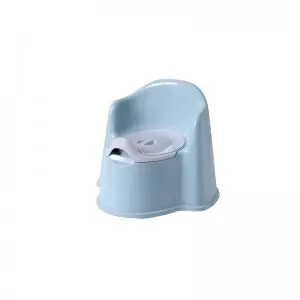Standard 1: The toilet seat must be wide to be comfortable
When the baby was training to use the toilet independently in the first year, I thought that all small toilets should look similar, so I bought one randomly online.
As a result, the baby disliked his small toilet less and less after sitting on it a few times. I was also puzzled.
It wasn’t until one day that I discovered that his white and tender buttocks were squeezed by the seat ring of the small toilet, leaving a deep red mark, and I realized that he didn’t like the small toilet because it was uncomfortable to sit on.
The narrow seat surface and the slightly spaced inside of the seat are really constricting. Originally, I had to relax my body to defecate, but in the end I resisted going to the toilet on my own because I didn’t choose the right toilet.
Standard 2: Baby potty must be stable
The small toilet must be stable. I have really stepped on big potholes. The problem still occurred with the first small toilet I bought. It had a three-leg shape and did not have any anti-slip rubber pads on the bottom of the legs.
In fact, it is stable to sit on, but the child will move around, or make big movements after standing up, and the small toilet will. After peeing, I stood up, and my pants caught the outer edge of the toilet, causing the toilet to overturn with the warm urine.

Standard 3: The toilet tank should not be too shallow, and it is best to have a “little hat” to prevent urine splashing
If the toilet trough is shallow, the baby will easily urinate and splash on his butt, or after peeing and then pooping, the baby will splash on his butt, or the baby’s butt will be stained with feces.
If the baby is splashed on his butt and feels uncomfortable, it is not ruled out that he will resist sitting on the toilet. Then, it will be more troublesome for parents to clean their baby’s buttocks. They have to wash the entire buttocks after wiping urine and feces.
In addition, the “little hat” mentioned to prevent splashing urine is mainly aimed at male babies. With this “little hat”, you don’t have to worry about peeing outside.
Standard 4: The seat must be able to match a large toilet, suitable for multiple stages, and make the best use of everything.
Generally speaking, babies can become familiar with small toilets, and after they fully accept the matter of using the toilet independently, they can be slowly guided to relieve themselves on the adult toilet.
After all, cleaning the toilet bowl and washing feces and urine N times a day really tests your patience. You can go directly to the big toilet and flush it immediately after defecation, which is perfect.
The first small toilet I bought had a very narrow seat. Although it could be placed on the toilet seat, it was unstable and basically useless.
Assuming that I can use it to successfully learn to use the toilet on my own, I still need to buy an additional baby seat that can be placed on the toilet, which is not cost-effective at all.
Post time: May-11-2024

